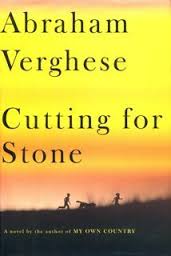Cutting for Stone by Abraham Verghese, USA, 2009
Verghese says about his book: “My ambition as a writer was to tell a great story, an old-fashioned, truth-telling story. But beyond that, my single goal was to portray an aspect of medicine that gets buried in the way television depicts the practice: I wanted the reader to see how entering medicine was a passionate quest, a romantic pursuit, a spiritual calling, a privileged yet hazardous undertaking”.
Cutting for Stone is an ambitious work about a small, intimate group of people living and working at a hospital called Missingin Addis Ababa, Ethiopia. Although only two of them are biologically connected, and the group is racially divergent (Ethiopians, Indians, Eritreans and British Indians), these people constitute what could be called a family, and the novel traces their lives from the 1940s through to the early 2000s.
The title can refer to a phrase taken from the Hippocratic Oath: “I will not cut for stone, even for patients in whom the disease is manifest; I will leave this operation to be performed by practitioners, specialists in this art… ” a phrase which refers to the travelling stone cutters of earlier centuries who cut out kidney and bladder stones, using unsanitary tools; it can also referto the two sons of the story, cutting for their father, Thomas Stone.
At the centre of the novel are Marion and Shiva Stone, the twin sons of a British surgeon and an Indian nun working at Missing hospital. Fate decrees, however, that the boys should be brought up by others (also doctors at the hospital), and it is not surprising that both boys choose medical careers. Much of the story is played out against a background of political unrest in Ethiopia, an unrest that eventually sees the twenty-five-year-old Marion move to USA. Marion grows up hating the father who abandoned him as a baby, and after an unfortunate episode when he is in his teens he also bears a grudge against the brother who he actually loves more than anyone else in the world. While he is in USA, circumstances force him to come to terms with both his hate and his grudge.
Abraham Verghese is a Professor of Medicine at Stanford, USA, and he is, therefore, qualified to write about ailments, operations and everything medical. I found the amount of medical jargon and reference to medical procedures – especially in the beginning of the novel – to be a little overwhelming, but as the book proceeds the medical aspects of the story become so integrated with the characters that the novel would probably seem lopsided without them. This is, after all, a story about doctors.
Even though the novel is basically fiction, it was interesting reading about Ethiopia, particularly from the point of view of health care, and, later in the book, it was equally interesting to look at the two-tiered approach to health care in USA and the gulf between well-equipped university hospitals and hospitals set up to care for poorer patients.
The story, though interesting, is not of the page-turning variety (not until the final thirty pages of its five hundred and thirty-four pages), and, at times, I found it slightly tedious. Certain episodes lack credibility: for example, the promiscuous activities and thoughts of thirteen-year-old children and the relationship between the surgeon and the nun, which, although it is at the centre of the novel, remains both surreal and nebulous.
Nevertheless, I enjoyed the novel, and I respected what Verghese was trying to do – even more so after reading the following comments of his from an interview:“As we’ve gotten very fancy in technology and the incredible detail with which we can see the body, we sometimes lose sight of how much we can see about the body just from examining the patient. The physical exam really allows you to order tests more judiciously and to ask better questions of the test” (…)“… We’re all intrinsically prone to allowing technology to take the place of common sense and I think that’s a danger. … The tests have become an easy shortcut. They’re an efficient, quick way to get information. But the great danger I see is this: I think that people fail to really connect with patients when they don’t examine them. I think the carefully done physical is a wonderful way to convey your attentiveness to the patient”.

Photo of Abraham Verghese from www.nytimes.com
